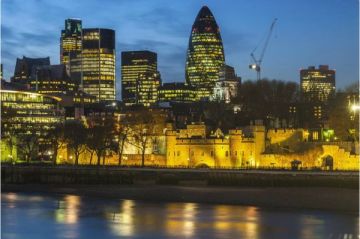
In some ways the medieval history of London can be said to have begun on Christmas Day, 1066, when William the Conqueror was crowned king of England in a ceremony at the newly finished Westminster Abbey, just three months after his victory at the Battle of Hastings.
William granted the citizens of London special privileges, but he also built a castle in the southeast corner of the city to keep them under control. This castle was expanded by later kings until it became the complex we now call the Tower of London.
The Tower acted as a royal residence, and it was not until later that it became famous as a prison. During the medieval period, it also acted as a royal mint, treasury, and housed the beginnings of a zoo.
In 1097 William II began the building of Westminster Hall, close by the abbey of the same name. The hall was to prove the basis of a new Palace of Westminster, the prime royal residence throughout the Middle Ages. On William's death, his brother Henry needed the support of London merchants to maintain his dubious grip on the throne. In exchange, Henry I gave city merchants the right to levy taxes and elect a sheriff.
By the early 12th century the population of London was about 18,000 (compare this to the 45,000 estimated at the height of Roman Britain). In 1123 St. Bartholomew's Priory was founded in the city, and other monastic houses quickly followed.
At one point in the medieval period there were 13 monasteries in the city. Today, these houses are remembered only by the names they gave to their areas, such as Greyfriars, Whitefriars, and Blackfriars.
The city played a role in the outcome of the struggle between Stephen and Maud for the crown in the 12th century. Although they initially supported Maud, her arrogant behaviour when she occupied Westminster so angered the citizens that they rose in revolt and Maud was forced to flee London.

In 1176 the first stone London Bridge was built, mere yards from the original Roman bridge across the Thames. This bridge was to remain the only one in London until 1739. Because the passage across this one bridge was narrow and clogged with traffic, it was much quicker and easier for travellers to hire waterboatmen to row them across the river, or transport them up or down river.
In 1191 Richard I acknowledged the right of London to self-government, and the following year saw the election of the first Mayor. This right was confirmed by later monarchs.
In 1245 Henry III began his lifetime work of rebuilding Westminster Abbey, which was reconsecrated in 1269. The other major building project of the medieval period was Old St. Paul's. The cathedral was finished in 1280.
In 1381 the city was invaded by peasants during the Wat Tyler's Peasants' Revolt. Although the major complaints of the peasants were aimed at the advisors of Richard II, they took advantage of their occupation of London to loot houses within the city. The Lord Mayor, William Walworth, stabbed Wat Tyler to death in a confrontation at Smithfield.
The London merchants supported Edward IV in his grab for the throne in 1461. In gratitude, Edward knighted many of the merchants. A few years later in 1477 William Caxton made history when he printed the first book on his new printing press near Westminster.
Daily Life
Medieval London was a maze of twisting streets and lanes. Most of the houses were half-timbered, or wattle and daub, whitewashed with lime. The threat of fire was constant, and laws were passed to make sure that all householders had fire-fighting equipment on hand. A 13th-century law required new houses to use slate for roofing rather than the more risky straw, but this seems to have been ignored.
The government of the city was by a Lord Mayor and council elected from the ranks of the merchant guilds. These guilds effectively ran the city and controlled commerce. Each guild had its own hall and their own coat of arms, but there was also the Guildhall (1411-40) where representatives of the various guilds met in common.
Many of the streets in the city were named after the particular trade which practised there. For example, Threadneedle Street was the tailor's district, Bread Street had bakeries, and on Milk Street cows were kept for milking. There was also a very active livestock market at Smithfield.
Plague was a constant threat, particularly because sanitation was so rudimentary. London was subject to no less than 16 outbreaks of the plague between 1348 and the Great Plague of 1665.
The prime real estate in London was the Strand, where many rich landowners built homes. Lawyers settled at the Temple and along Fleet Street. The Fleet River (which was called the Holborn) was navigable by boats, and docks were set up at what is now Farringdon Street. The Fleet River was covered over in the 18th century.
What to See:
London Guildhall
Tower of London
Westminster Abbey
Inns of Court
St Bartholomew-the-Great
Temple Church
London Medieval Attractions - from our Heritage Traveller blog
<< Back Anglo-Saxon
Next >> Tudor London
London History
Roman | Anglo-Saxon | Medieval | Tudor | Stuart | Georgian | Victorian | 20th century London
English History
Also see "English History" and our award-winning "English Culture" section.

